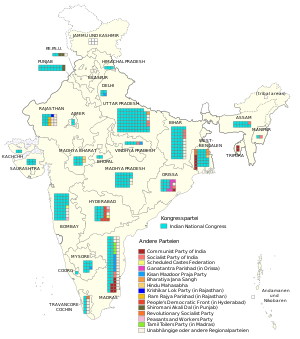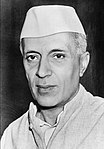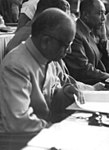Indian general election, 1951–52
| |||||||||||||||||||||||||
All 489 seats in the Lok Sabha 245 seats were needed for a majority | |||||||||||||||||||||||||
|---|---|---|---|---|---|---|---|---|---|---|---|---|---|---|---|---|---|---|---|---|---|---|---|---|---|
| |||||||||||||||||||||||||
 | |||||||||||||||||||||||||
| |||||||||||||||||||||||||
The Indian general election of 1951–52 elected the first Lok Sabha since India became independent in August 1947.[1][2][3]
Until this point, the Indian Constituent Assembly had served as an interim legislature. See the 'Durations' section below to find the time-range associated with these elections.
The Indian National Congress (INC) won a landslide victory, winning 364 of the 489 seats and 45% of the total votes polled. This was over four times as many votes as the second-largest party. Jawaharlal Nehru became the first democratically elected Prime Minister of the country. In the first Lok Sabha polls held in 1951, India had around 173 million voters, out of an overall population of about 360 million.[4] Voter turnout was 45.7%.[5]
Contents
1 Parties
2 Constituencies
3 Results
4 Notable losses
5 Government formation
6 Duration
7 See also
8 References
9 Further reading
Parties
Before Independent India went to the polls, two former cabinet colleagues of Nehru established separate political parties to challenge the INC's supremacy. While Shyama Prasad Mookerjee went on to found the Jana Sangh in October 1951, First Law Minister Dr. B. R. Ambedkar revived the Scheduled Castes Federation (which was later named the Republican Party). Other parties which started coming to the forefront included the Kisan Mazdoor Praja Parishad, whose prime mover was Acharya Kripalani; the Socialist Party, which had Ram Manohar Lohia and Jayaprakash Narayan's leadership to boast of; and the Communist Party of India. However, these smaller parties were unable to make an electoral stand against the Indian National Congress.
Constituencies
The first general elections, which were conducted for 489 seats in 401 constituencies, represented 25 Indian states. At that time, there were 314 constituencies with one seat, 86 with two seats and one with three seats.[6]
The multi-seat constituencies were abolished in the 1960s. There were also 2 nominated Anglo-Indian members.
Results
| Party | Abbr. | Votes | % | Seats |
|---|---|---|---|---|
| Akhil Bharatiya Hindu Mahasabha | ABHM | 0.95 | 4 | |
| Akhil Bharatiya Ram Rajya Parishad | RRP | 1.97 | 3 | |
| Bharatiya Jana Sangh | BJS | 3,246,288 | 3.06 | 3 |
| Bolshevik Party of India | BPI | 0.02 | 0 | |
| Communist Party of India | CPI | 3,484,401 | 3.29 | 16 |
| Forward Bloc (Marxist) | FB(M) | 0.91 | 1 | |
| Forward Bloc (Ruiker) | FB(R) | 0.13 | 0 | |
| Indian National Congress | INC | 47,665,875 | 44.99 | 364 |
| Krishikar Lok Party | KLP | 1.41 | 1 | |
| Kisan Mazdoor Praja Party | KMPP | 6,156,558 | 5.79 | 9 |
| Revolutionary Communist Party of India (Tagore) | RCPI | 0.06 | 0 | |
| Revolutionary Socialist Party | RSP | 0.44 | 3 | |
| Scheduled Caste Federation | SCF | 2.38 | 2 | |
| Socialist Party | SP | 11,266,779 | 10.59 | 12 |
| All India Republican Party | REP | 0.04 | 0 | |
| All India Republican Party | RPP | 0.05 | 0 | |
| All India United Kisan Sabha | UKS | 0.06 | 0 | |
| All Manipur National Union | AMNU | 0.02 | 0 | |
| All People's Party | APP | 0.03 | 0 | |
| Chota Nagpur Santhal Parganas Janata Party | CNSPJP | 0.22 | 1 | |
| Cochin Party | CP | 0.01 | 0 | |
| Commonweal Party | CWP | 0.31 | 3 | |
| Ganatantra Parishad | GP | 0.91 | 6 | |
| Gandhi Sebak Seva | GSS | 0.01 | 0 | |
| Hill Peoples Party | HPP | 0.02 | 0 | |
| Historical Research | HR | 0.00 | 0 | |
| Hyderabad State Praja Party | HSPP | 0.01 | 0 | |
| Jharkhand Party | JKP | 0.71 | 3 | |
| Justice Party | JP | 0.06 | 0 | |
| Kamgar Kisan Paksha | KKP | 0.13 | 0 | |
| Kerala Socialist Party | KSP | 0.1 | 0 | |
| Khasi-Jaintia Durbar | KJD | 0.03 | 0 | |
| Kisan Janata Sanyukta Party | KJSP | 0.01 | 0 | |
| Kisan Mazdoor Mandal | KMM | 0.01 | 0 | |
| Kuki National Association | KNA | 0.01 | 0 | |
| Lok Sevak Sangh | LSS | 0.29 | 2 | |
| Madras State Muslim League Party | MSMLP | 0.08 | 1 | |
| National Party of India | NPI | 0.00 | 0 | |
| Peasants and Workers Party of India | PWPI | 0.94 | 2 | |
| Peoples Democratic Front | 1.29 | 7 | ||
| Praja Party | PP | 0.02 | 0 | |
| Punjab Depressed Class League | PDCL | 0.01 | 0 | |
| Pursharathi Panchayat | PURP | 0.01 | 0 | |
| Revolutionary Socialist Party (Uttar Pradesh) | RSP(UP) | 0.02 | 0 | |
| Shiromani Akali Dal | SAD | 0.99 | 4 | |
| S.K. Paksha | SKP | 0.13 | 0 | |
| Saurashtra Khedut Sangh | SKS | 0.03 | 0 | |
| Tamil Nadu Toilers Party | TNTP | 0.84 | 4 | |
| Tail Nadu Congress Party | TNCP | 0.03 | 0 | |
| Tribal Sangha | TS | 0.11 | 0 | |
| Travancore Tamil Nadu Congress Party | TTNC | 0.11 | 1 | |
| Uttar Pradesh Praja Party | UPP | 0.2 | 0 | |
| Zamindar Party | ZP | 0.27 | 0 | |
| Independents | 16,817,910 | 15.9 | 37 | |
| Nominated Anglo-Indians | – | – | 2 | |
| Total | 105,944,495 | 100 | 489 | |
Notable losses
First Law Minister B. R. Ambedkar was defeated in the Bombay (North Central) (reserved seat) constituency as Scheduled Castes Federation candidate by his little-known former assistant and Congress Candidate Narayan Sadoba Kajrolkar, who polled 1,38,137 votes compared to Ambedkar's 1,23,576 votes.[7]:156
Dr Ambedkar then entered the parliament as a Rajya Sabha member. He contested by-poll from Bhandara in 1954 to try to enter Lok Sabha but again lost to Mr Borkar of Congress.
Acharya Kripalani lost from Faizabad in UP as KMPP candidate, but his wife Sucheta Kripalani defeated the Congress candidate Manmohini Sahgal in Delhi.[8]
Government formation
The speaker of the first Lok Sabha was Ganesh Vasudev Mavalankar. The first Lok Sabha also witnessed 677 sittings (3,784 hours), the highest recorded count of the number of sitting hours. The Lok Sabha lasted its full term from 17 April 1952 until 4 April 1957.
Duration
While Indian Government's official websites and official documents assign the year 1951 to these polls, it is a misrepresentation because all territories except Himachal Pradesh and Jammu & Kashmir voted in February–March 1952; no polls were held for Lok Sabha seats in Kashmir until 1967, and only Himachal Pradesh voted in 1951 for the first Lok Sabha because weather tends to be inclement in February and March, heavy snow impending free movement.[9] The rest of the India voted only in February–March 1952 for the Lok Sabha and Vidhan Sabha elections. Polling was held between 25 October 1951 and 27 March 1952. The very first votes of the election were cast in the tehsil (district) of Chini in Himachal Pradesh.[7]
See also
- Election Commission of India
- Indian presidential election, 1952
References
^
"Lok Sabha Results 1951-52". Election Commission of India..mw-parser-output cite.citation{font-style:inherit}.mw-parser-output q{quotes:"""""""'""'"}.mw-parser-output code.cs1-code{color:inherit;background:inherit;border:inherit;padding:inherit}.mw-parser-output .cs1-lock-free a{background:url("//upload.wikimedia.org/wikipedia/commons/thumb/6/65/Lock-green.svg/9px-Lock-green.svg.png")no-repeat;background-position:right .1em center}.mw-parser-output .cs1-lock-limited a,.mw-parser-output .cs1-lock-registration a{background:url("//upload.wikimedia.org/wikipedia/commons/thumb/d/d6/Lock-gray-alt-2.svg/9px-Lock-gray-alt-2.svg.png")no-repeat;background-position:right .1em center}.mw-parser-output .cs1-lock-subscription a{background:url("//upload.wikimedia.org/wikipedia/commons/thumb/a/aa/Lock-red-alt-2.svg/9px-Lock-red-alt-2.svg.png")no-repeat;background-position:right .1em center}.mw-parser-output .cs1-subscription,.mw-parser-output .cs1-registration{color:#555}.mw-parser-output .cs1-subscription span,.mw-parser-output .cs1-registration span{border-bottom:1px dotted;cursor:help}.mw-parser-output .cs1-hidden-error{display:none;font-size:100%}.mw-parser-output .cs1-visible-error{font-size:100%}.mw-parser-output .cs1-subscription,.mw-parser-output .cs1-registration,.mw-parser-output .cs1-format{font-size:95%}.mw-parser-output .cs1-kern-left,.mw-parser-output .cs1-kern-wl-left{padding-left:0.2em}.mw-parser-output .cs1-kern-right,.mw-parser-output .cs1-kern-wl-right{padding-right:0.2em}
^
"Statistical Report on Lok Sabha Elections 1951-52" (PDF). Election Commission of India.
^
"Lok Sabha Elections Stats Summary 1951-52" (PDF). Election Commission of India.
^ India has nearly 83 crore voters: Brahma
^ Dieter Nohlen, Florian Grotz & Christof Hartmann (2001) Elections in Asia: A data handbook, Volume I, p. 572
ISBN 0-19-924958-X
^
"General Election of India 1951, List of Successful Candidate" (PDF). Election Commission of India. p. 6. Archived from the original (PDF) on 8 October 2014. Retrieved 12 January 2010.
^ ab
Ramachandra Guha (2008). India After Gandhi: The History of the World's Largest Democracy. ISBN 978-0-06-095858-9.
^ David Gilmartin (2014). "Chapter 5: The paradox of patronage and the people's sovereignty". In Anastasia Pivliavsky. Patronage as Politics in South Asia. Cambridge University Press. pp. 151–152. ISBN 978-1-107-05608-4.
^ India's first voter in Himachal Pradesh, by Gautam Dhmeer, in the Deccan Herald; published 30 October 2012; retrieved 7 April 2014
Further reading
- Guha, Ramachandra. "Democracy's Biggest Gamble," World Policy Journal, (Spring 2002) 19#1 pp. 95–103

